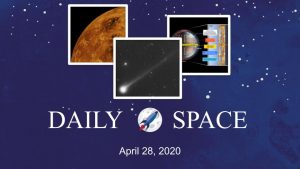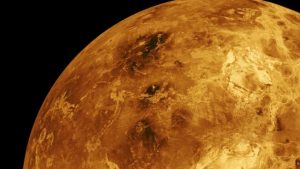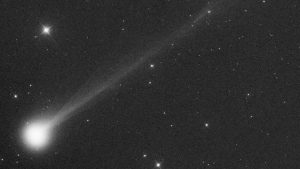
Images from the Akatsuki spacecraft unveil what keeps Venus’s atmosphere rotating much faster than the planet itself, for the first time, NASA’s Neil Gehrels Swift Observatory tracked water loss from an interstellar comet as it approached and rounded the Sun, and then we have an interview with Patrick Peplowski about what they’ve learned about MESSENGER visiting Venus.
Links
Akatsuki spacecraft unveils what keeps Venus’s atmosphere rotating much faster than the planet itself
For the first time, NASA’s Neil Gehrels Swift Observatory tracked water loss from an interstellar comet as it approached and rounded the Sun
Transcript
This is the Daily Space for today, Tuesday, April 28, 2020. I am your host Dr. Pamela Gay, and I am here to put science in your brain.
Today’s space news is trying to be a good role model for all of us; it is sticking close to home. After taking a quick tour of news from Venus, Comet Borisov and Comet Swan, we will be joined by Dr Patrick Peplowski, a researcher at the Johns Hopkins University Advanced Physics Lab, who was part of the team who determined how to use MESSENGER data to study the nitrogen of Venus’ atmosphere.

While unrelated to Peplowski’s work, our first story starts at Venus. This world is currently orbited by a Japanese mission called Akatsuki. Also called the Venus Climate Orbiter, this space probe is studying how the different layers of Venus’ opaque clouds are structured and flowing.
One of odder mysteries of this world is how it ended up with clouds that flow rapidly around a world whose day is longer than its year. For every single Venusian day, the wind cycles 60 times. To be fair, the Venusian day is 243 Earth days long, but this rapid wind circulation is still inexplicably fast. Or at least it was inexplicable. We may start to have a beginning of understanding.

Takeshi Horinouchi of Hokkaido University, developed a new method to track clouds and wind velocities. Winds are generally driven by pressure and temperature variations, as air flows from high pressure to low pressure regions. On Venus, the temperature structure is particularly complex because there is a gradual temperature gradient from the cool poles to the hot equator. There is also a dramatic gradient between the day and night sides of the planet. These variations drive to massive atmospheric cells that from pole to equator that are complimented by a massive equatorial flow. This super rotating circulation pushes the clouds in what is poetically referred to as a tidal wave of cloud.
While Venus isn’t tidally locked to the Sun, its slow rotation is a good approximation, and the work being done to understand Venus’ atmosphere will aid in our modeling of what happens on those alien worlds. This work is published in new research published in Science magazine.
From Venus, we now turn to Comet 2I/Borisov. This interstellar asteroid has been a target of opportunity for pretty much anything that could point at his sublimating form. As we discussed last week, the chemistry of Borisov isn’t identical to what we generally have here in our Solar System, with carbon monoxide appearing in greater amounts than expected. Now, new observations from the Swift mission find that Borisov is 10 times more active than the standard comet. With a total surface roughly twice the size of Central Park, it was able to shed 8 gallons of water per second at its peak output. As it approached the Sun, this water spray dropped in volume, most likely due to surface erosion, rotational changes, and the fragmentation that was eventually observed by Hubble. While still within the observed range of possible comet behaviors, Borisov doesn’t neatly match any category of comet we’ve seen before. This is consistent with it having a different formation history, with colder temperatures and still to be understood other variations. As we’ve said before, we need to see more interstellar asteroids to understand what is, at the galaxy level, the oddity and the average for comets.

While we don’t have any new interstellar comets at the moment, we do have a nice bright regular comet to fill the gap left when Comet Atlas fell apart. Comet Swan was found in data by SOHO’s Solar Wind ANistropies by amatuer astronomer Michael Mattiazzo. This small comet Is on an odd orbit that is tilted 111 degrees relative to the ecliptic plane. This icy body is now bright enough to see in binoculars, and might possibly become an object bright enough to see with the unaided eye. On May 12, this object will pass near Earth on its way in toward its closest approach to the Sun on May 27. This isn’t an ideal geometry, but it does mean there is a good chance Swan won’t fall apart before it gets close to us. For now, all we can do is wait and see … and hope.. Maybe 2020 will give us one bright comet while it systematically takes everything else away.
And that rounds out our news, but don’t go anywhere. We’re going to bring on our guest, Dr Patrick Peplowski, so we can talk about Venus’s mysterious atmosphere’s unusual nitrogen behavior.
<———————>
Thank you all for listening. Today’s script was written by Pamela Gay, and the Daily Space is produced by Susie Murph. The Daily Space is a product of the Planetary Science Institute, a 501(c)3 non profit dedicated to exploring our Solar System and beyond. We are here thanks to the generous contributions of people like you. The best way you can support us is through Patreon.com/cosmoquestx Like us? Please share us! You never know whose life you can change by adding a daily dose of science.


 We record most shows live, on Twitch. Follow us today to get alerts when we go live.
We record most shows live, on Twitch. Follow us today to get alerts when we go live.